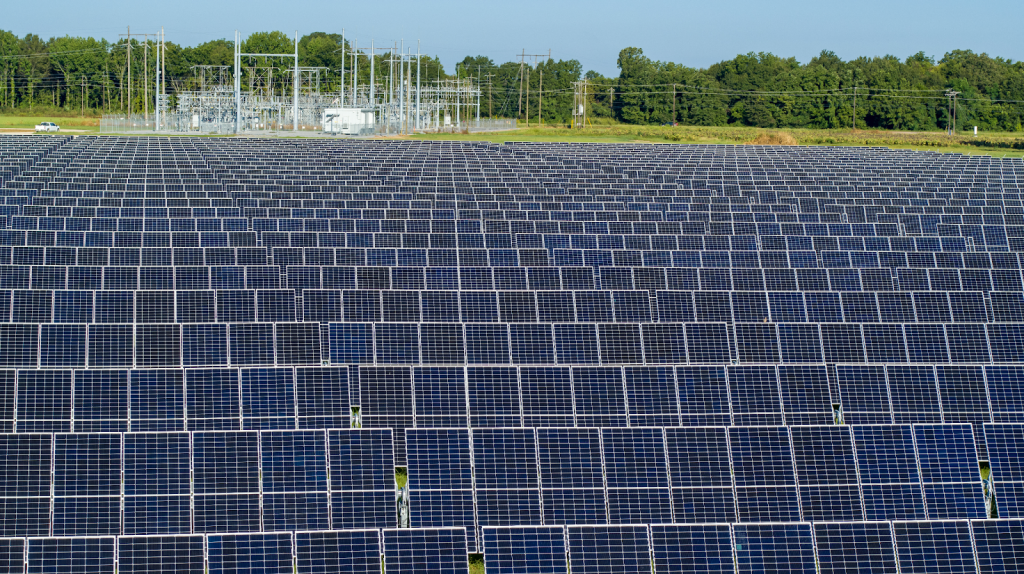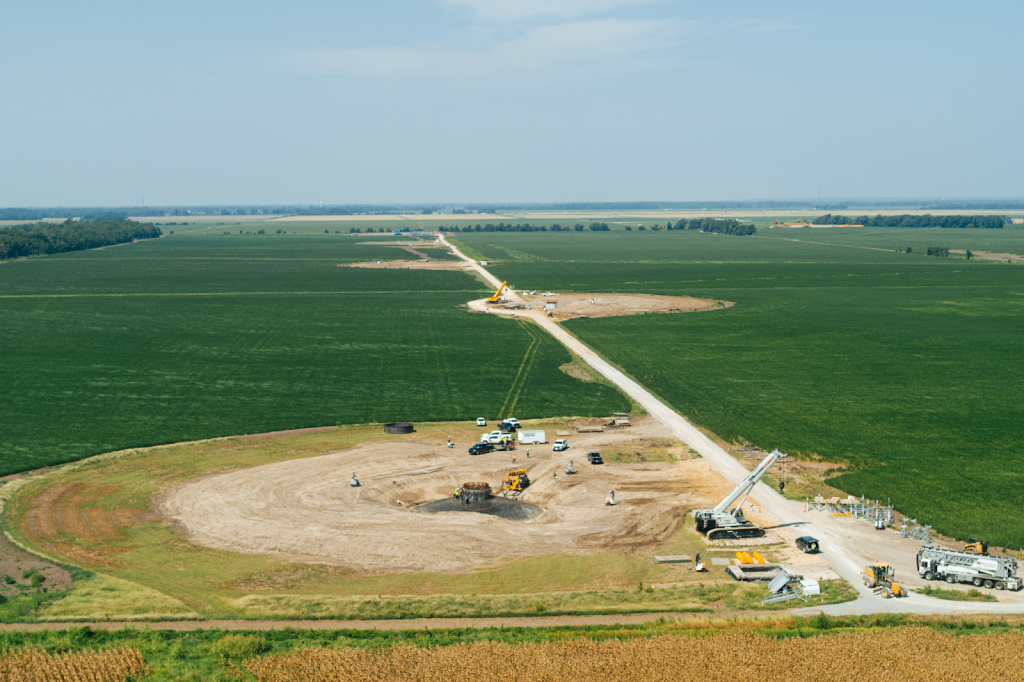There are sunny days ahead for the renewable energy industry in Mississippi.
In September 2022, energy provider Entergy completed construction on a 100-megawatt, utility-scale solar farm — one of the first and largest in the state. Sunflower Solar Site sits on 1,000 acres of land in the Mississippi Delta, near Ruleville in Sunflower County.
The power station capitalizes on some of the state’s most abundant resources: open land and the sun. It generates enough energy per year to power 16,400 homes, all of which use Entergy’s Sunflower County power grid.
“During peak condition, on the sunniest day, the solar station can produce 100 megawatts,” operations planning manager Landon Eskew said. “It’s producing 100% renewable, emissions-free energy for the customers of Mississippi, so it’s something we’re real proud of.”
Sunflower Solar Site lays the groundwork for further investment from Entergy in Mississippi renewables. It joins three Entergy-built, privately owned solar farms in the state and 36 more in other states that Entergy covers, including Arkansas, Louisiana and Texas. The company plans to have opened four more utility-scale farms in Mississippi by 2026 or 2027.
“Renewables are a big part of our future. Entergy, the whole corporation, has committed to get to net zero carbon emissions, and solar energy is going to be a big part of that,” Eskew said. “We have a couple of interim goals in the middle, but 2050 is the ultimate net-zero goal.”
Though its focus is on solar energy, Eskew did not rule out the possibility of Entergy investing in wind-harnessing technologies.
“Wind is another renewable energy source that we’re looking at. There’s nothing definitive there, but that’ll be next in line,” Eskew said. “But it’s solar first with its development and where it is with the technology. It’s the front runner right now in renewables.”
Entergy’s prioritization of solar power reflects a nationwide trend. Patrick Sullivan, director of the Mississippi Energy Institute, a nonprofit that researches energy-related economic development, says that solar energy is burgeoning both in Mississippi and across the country.
“(Solar energy) is the fastest growing source of electric power generation in the nation,” Sullivan said. “It still makes up a relatively small percentage nationally, but it’s more than it was a few years ago. Now, it is the fastest growing area in terms of investment in construction.”
State Climatologist and Mississippi State University Professor of Climatology Mike Brown favors solar as Mississippi’s best option for renewables. He cited the ease with which solar panels can be put up, arguing for solar panels to be incorporated into urban areas, rather than trees and crops being razed to make room for solar farms.

“Solar is our best source here in Mississippi,” Brown said. “But we’ve got to get smart about where we put these farms. We need to put them in areas where we’re not going to disrupt agriculture. Why we aren’t putting solar panels on top of those garages is beyond me. Or why in our parking lots we don’t have elevated solar panels that you park under.”
While solar panels are yet to be implemented in Mississippi’s urban areas, rural solar farms are on the rise. Sunflower Solar Station joins two other utility-scale solar farms in Mississippi: Silicon Ranch’s Meridian Solar and Origis Energy’s Sumrall Solar Farms, located in Lauderdale County and Sumrall County, respectively. Amazon is also constructing a 175-megawatt solar farm in Scott County, set to begin operations in 2024.
The importance of agriculture to Mississippi also prevents the state from capitalizing on what could seemingly be a behemoth for renewable energy: rivers.
“I don’t think we’ve harnessed hydroelectric energy because damming those rivers, the Mississippi River and the Pearl River, would be detrimental to our agriculture,” Brown said. “Those (rivers) provide water to our main aquifer that our farmers pump out of to irrigate their crops. If we did anything to those rivers, I think it would cost us more than it would benefit us.”
Brown also expressed skepticism at the viability of wind energy production in Mississippi.
“It’s not cost-effective to put up wind turbines here in the state of Mississippi because we don’t have the wind to generate the power,” he said. “As the technology develops, it could be done, but we just don’t see the winds (here) like we do in the Southwest.”
This has not stopped Amazon from funding the construction of Mississippi’s first utility-scale wind farm. Delta Wind will consist of 41 turbines on 14,000 acres of land in Tunica County. Once completed, the project will be operated by energy consulting company Applied Energy Services.
“We chose this specific location because of the landowner’s participation in our partnership with Tunica County’s zoning and permitting leadership,” Applied Energy Services stakeholder relations analyst Chanel Guidry said.
According to Guidry, Applied Energy determined that Tunica County is windy enough for the farm to be productive.
“The location is in a regionally high wind resource area in comparison to other parts of the state,” she said. “(Mississippi) is not as windy as many other states, but it’s enough wind for us to make it work.”
If successful, Delta Wind will provide amounts of electricity to Mississippians unprecedented by other forms of renewable energy.
“It is a 184-megawatt project, and it will generate enough energy to power more than 80,000 homes in Mississippi annually,” Guidry said.
Wind energy has distinct benefits, namely that it encourages rather than disrupts agriculture.
“The nice thing about wind turbines is that you can put them on a farm and they don’t have a big footprint. You can farm around those things, and the farmer doesn’t lose much,” Brown said. “But we gain a lot of electricity.”

Delta Wind is taking advantage of this fact, building on agricultural land on which rice, soybeans, corn and wheat will continue to be grown.
A downside of both solar and wind energy production is that once construction is complete, neither creates permanent jobs. While Delta Wind expects to employ 300 people at peak construction, there is no indication of how many people will continue to work there. Likewise, the Sunflower Solar Site has few permanent employees.
“There aren’t many employees at the solar farm itself,” Eskew said. “Obviously during construction, there was a significant number of employees, but now we keep maybe three full-time employees at the site.”
By comparison, the oil and gas industry in Mississippi creates upward of 97,000 jobs.
This is one reason why Sullivan advocates for the gradual and practical implementation of renewable energy. Not only does the fossil fuel industry employ tens of thousands of people, countless more renewable projects will be needed to make a dent in natural gas consumption.
“Statewide, about 75% to 80% (of commercial energy) is derived from natural gas,” Sullivan said. “Nuclear’s around 14%, coal makes up about 8% and then there’s a small percentage, about 1%, made up of solar production.”
Despite its undeniable benefits, renewable energy will serve a supplementary role to natural gas energy until renewables’ production infrastructure is robust enough to account for a significant portion of energy consumption.
“The sunshine is free and the wind is free. You’ve got to build the stuff to collect the energy, but you don’t have to pay for the result, like paying for the fuel with natural gas,” Sullivan said. “But the downside of renewables is that you can’t really control how much it generates and when it generates. So it’s important for them to be a complementary part of a bigger system. With energy, you want to have enough supply and enough stable supply.”



























